Christmas Tree History: Pagan Origins Revealed
When you think of Christmas trees, you may associate them with the Christian celebration of the birth of Jesus Christ. However, the origins of the Christmas tree actually lie in pagan customs and traditions that span back thousands of years.
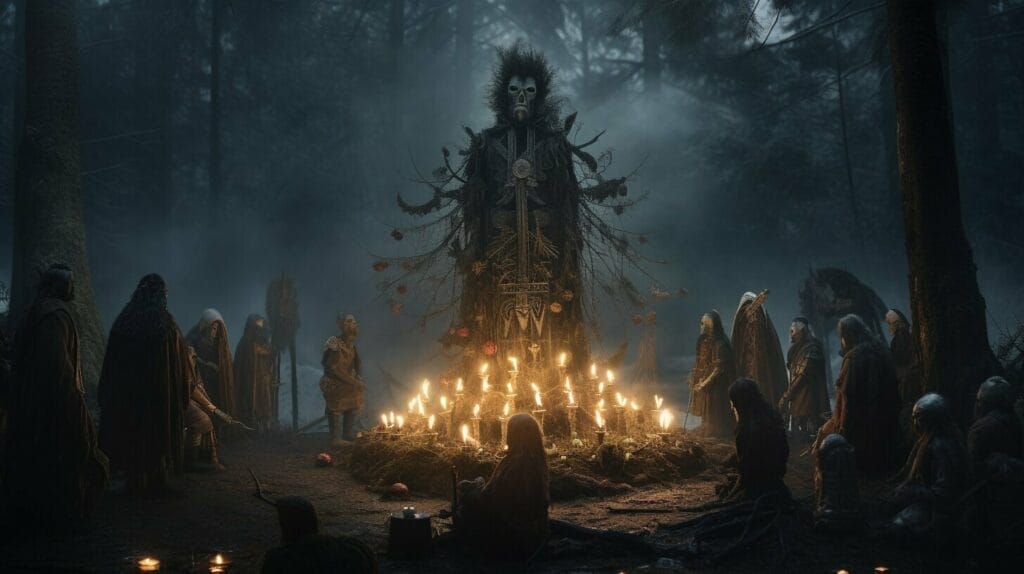
Ancient cultures, such as the Druids and Germanic tribes, revered trees as sacred symbols of fertility, immortality, and rebirth. The Yuletide tree, for example, was celebrated during the Winter Solstice as a representation of the earth’s renewal and regeneration.
As the centuries passed, the Christmas tree evolved from its pagan roots into the Christian adaptation we know today. However, the enduring symbolism and significance of the evergreen tree have remained a central part of winter festivals and Christmas traditions throughout the world.
Quick Summary
- The Christmas tree has its origins in pagan customs and traditions that date back thousands of years.
- Ancient cultures revered trees as symbols of fertility, immortality, and renewal, particularly during winter festivals such as the Winter Solstice and Yuletide.
- The Christmas tree evolved from its pagan roots into the Christian adaptation we know today.
- However, the enduring symbolism and significance of the evergreen tree have remained a central part of winter festivals and celebrations throughout the world.
- Understanding the history and significance of the Christmas tree can enrich your appreciation of this beloved holiday tradition.
Winter Solstice and Druids’ Sacred Tree Worship
As you delve into the history of the Christmas tree, you’ll find that it has its roots in ancient tree worship customs. One such custom was the Druids’ sacred tree worship, which was intertwined with the Winter Solstice, an important celestial event. The Druids had a deep reverence for nature and believed that trees were sacred beings that symbolized the cycle of life, death, and rebirth.

During the Winter Solstice, the Druids would decorate trees with gold and silver ornaments, symbolizing the sun and the moon, and light candles to honor their sacred trees. They believed that this practice would bring back the warmth and light of the sun, making the days longer and the nights shorter. It was a time of rebirth and renewal, as the Earth began to awaken from its winter slumber.
The Druids also believed that their sacred trees were inhabited by spirits, and by decorating them, they were inviting these spirits to join in their celebrations. The trees were seen as a gateway to the spirit world, and it was believed that the spirits could bestow blessings and good fortune upon those who honored them.
Over time, the practice of decorating trees during the Winter Solstice spread across Europe, becoming a widespread tradition during pagan festivals. It is from these pagan customs that the Christmas tree as we know it today evolved.
The Winter Solstice and Druids’ Sacred Tree Worship
The Winter Solstice and Druids’ Sacred Tree Worship are rooted in pagan rituals and beliefs. The ancient practice of decorating trees during the Winter Solstice has its origins in the Druids’ sacred tree worship. The Druids believed that trees were sacred and that they symbolized the cycle of life, death, and rebirth.
“During the Winter Solstice, the Druids would decorate trees with gold and silver ornaments, symbolizing the sun and the moon, and light candles to honor their sacred trees.”
The practice of decorating trees during the Winter Solstice later became a widespread tradition during pagan festivals, and it is from these practices that the Christmas tree evolved.
Germanic Tribes and the Yule Celebration
During the Yule celebration, Germanic tribes would revere trees as part of their pre-Christian veneration. This practice was deeply ingrained in their culture and reflected their connection to the natural world.
Germanic people believed that trees were home to spirits, which included gods and goddesses. They also believed that trees held immense wisdom and could provide guidance to those who sought it. This reverence for trees is reflected in their many myths, legends, and folklore.
As part of their Yule celebration, Germanic tribes would decorate trees with fruits, nuts, and other items that symbolized prosperity and abundance. These practices were deeply rooted in their culture and were later adopted by Christian traditions.
Pre-Christian Tree Veneration
Pre-Christian Germanic tribes believed that trees were central to their spiritual practices. They would often hold rituals and ceremonies around trees, seeking guidance from the spirits that resided within them. Their reverence for trees was closely tied to their understanding of the natural world and their place within it.
They believed that trees were sacred and that they held great power. They would often leave offerings, such as food or drink, at the base of trees to show their respect and gratitude. This practice was a way for them to connect with the earth and the spiritual world.
Celtic Tree Worship Rituals
The Germanic tribes’ Yule celebration was similar to the Celtic tree worship rituals. The Celts also viewed trees as sacred and believed that they held immense power. They would often decorate trees with symbols and offerings that represented different aspects of their culture.
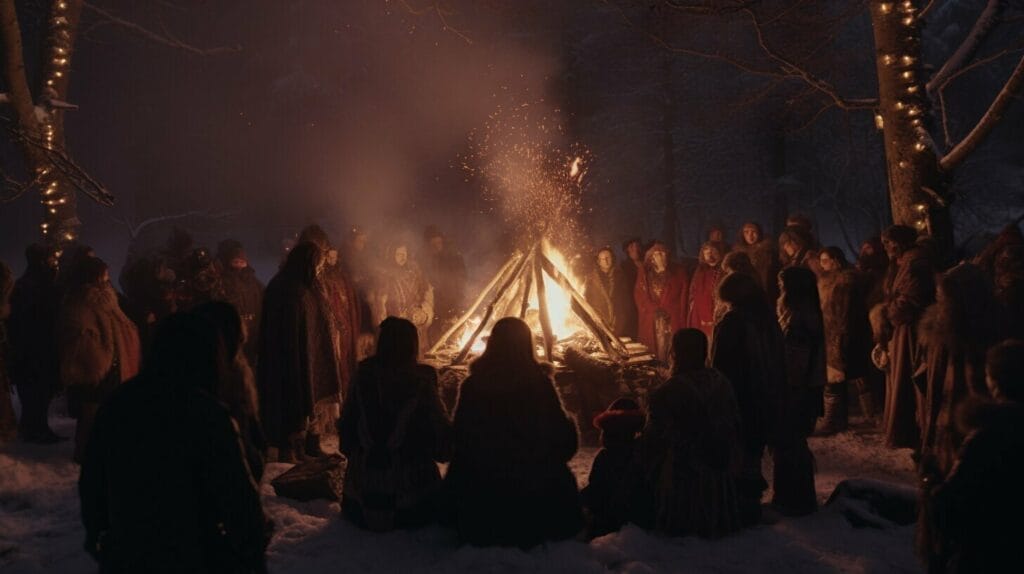
These rituals were an integral part of their spiritual practices and were passed down through generations. Their reverence for trees was also reflected in their mythology and folklore. The Celts believed that trees were home to fairies and other magical beings.
The practice of decorating trees during the Yule celebration was commonplace among ancient cultures. This tradition has endured through the ages, and today we continue to decorate trees as part of our Christmas celebrations.
In the next section, we will explore the influence of the Roman festival of Saturnalia on the Christmas tree tradition.
Roman Saturnalia and the Tree Connection
During the Roman festival of Saturnalia, which took place from December 17th to 23rd, trees played an integral role in the celebrations. Romans would decorate trees with small pieces of metal and replicas of their god, Bacchus. These tree decorations were believed to bring good luck and prosperity to their homes. The trees themselves were also seen as symbols of life and fertility, with the fir tree being a popular choice due to its evergreen nature.
The influence of Saturnalia on the Christmas tree tradition is evident, with the use of tree decorations being incorporated into early Christmas celebrations. The merging of these traditions with pagan customs was further solidified during the Middle Ages. The use of evergreen trees continued to be popular during Christmas celebrations, and the inclusion of tree decorations became a standard practice.
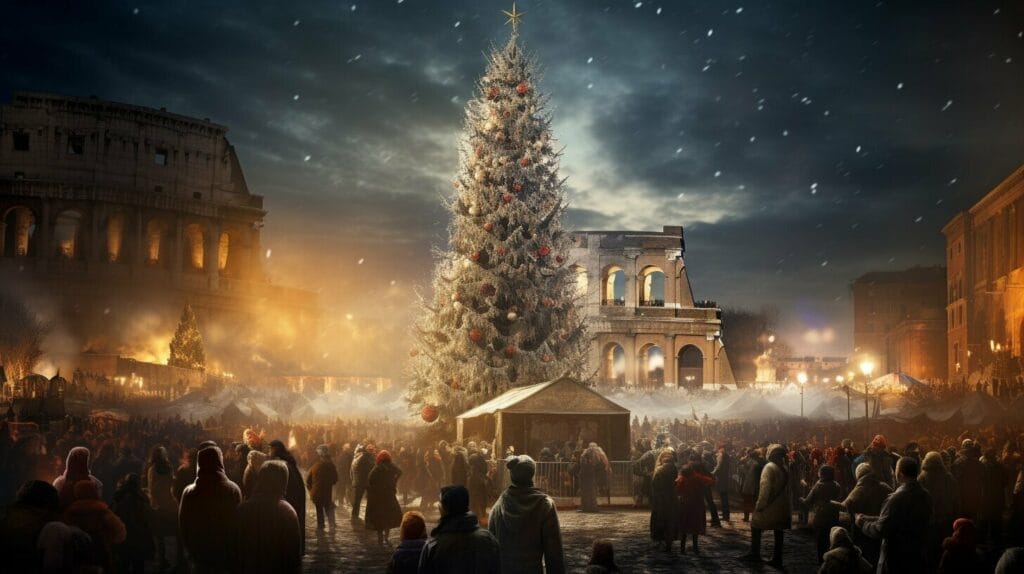
Celtic tree worship rituals also played a role in the evolution of the Christmas tree tradition. The Celts believed that certain trees had special powers and were sacred, and so they would decorate these trees during their own winter solstice celebrations. The use of tree decorations and the reverence for evergreen trees were practices that easily blended with the Roman and Germanic traditions, ultimately shaping the modern-day Christmas tree.
The Connection Between Saturnalia and the Christmas Tree
The tree decorations used during Saturnalia were not unlike the ornaments used to decorate Christmas trees today. The use of these decorations symbolized the hope for a prosperous future and the continuation of life, beliefs that were central to both Roman and Christian celebrations.
“The use of evergreen trees continued to be popular during Christmas celebrations, and the inclusion of tree decorations became a standard practice.”
The merging of pagan customs with Christian practices was not a new phenomenon, as it had occurred during the spread of Christianity in other parts of Europe. The inclusion of tree worship into Christmas celebrations was a natural progression of this blending of cultures. It allowed for the retention of ancient customs and traditions while also promoting Christian teachings.
The connection between Saturnalia and the Christmas tree is just one example of how the holiday traditions we celebrate today have evolved over time. Understanding the origins and evolution of these customs can further enhance the meaning and significance of the Christmas season.
Norse Mythology and the Yggdrasil Connection
The ancient decorating practices of trees had a significant influence on the adoption of the Christmas tree during the medieval period. The evergreen tree held a special place in pagan societies and was a symbol of eternal life and renewal.
According to Norse mythology, Yggdrasil was an enormous tree that held the nine realms of existence together. It was believed that this tree was the source of all life and that it connected the gods, humans, and spirits.
The ancient tree decorating practices included hanging the branches of evergreen trees inside homes during the winter solstice. This practice symbolized life and growth during a time of darkness and death.
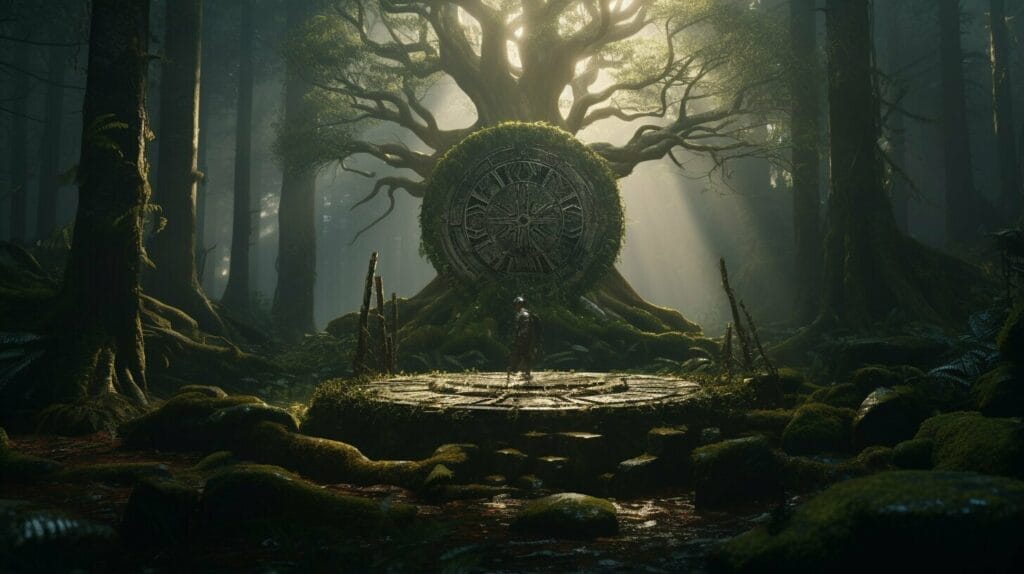
As Christianity began to spread, the pagan tradition of decorating trees became intertwined with Christian practices. This blending of customs eventually led to the adoption of the Christmas tree in modern times.
It’s interesting to note that despite the Christian adaptation of the Christmas tree, ancient traditions and practices continue to influence modern celebrations. Whether you’re decorating your tree with lights and ornaments or simply admiring its beauty, the significance of the evergreen tree remains as strong as ever.
Pagan to Christian Transition: The Evolution of the Christmas Tree
As the Christmas tree tradition evolved over time, it underwent significant changes, particularly during the Renaissance and Victorian eras. The transition from pagan customs to Christian adaptation brought about new symbolism and popularity to the evergreen tree.
The Renaissance era witnessed a significant shift in the Christmas tree’s evolution. The tree was no longer just a symbol of pagan worship but became a widespread symbol of the holiday season. This was largely due to the influence of artistic depictions of the Nativity scene, which featured a central Christmas tree as part of the celebration.
During the Victorian era, the popularity of the Christmas tree continued to grow, particularly in England. Prince Albert, the husband of Queen Victoria, is often credited with introducing the German tradition of decorating the Christmas tree to the English. The Queen and her family were depicted in the media with Christmas trees, which helped to popularize the custom in the general population.
The Christmas tree’s evolving symbolism reflects the transition from pagan to Christian customs. The evergreen tree, which represented the eternal life force in ancient pagan practices, gradually took on new meanings. The Christian adaptation symbolized everlasting life through Jesus Christ, with the tree serving as a representation of hope and light in the dark winter months.
The Victorian era also introduced the tradition of decorating the Christmas tree with ornaments. The ornaments represented a variety of things, including religious themes, as well as representations of nature and animals. This practice further fused the pagan reverence for evergreen with Christian customs.
The evolution of the Christmas tree is a testament to the enduring influence of ancient customs and practices. The pagan to Christian transition was a slow process, but it eventually led to a new kind of symbolism and meaning for the beloved holiday tree.
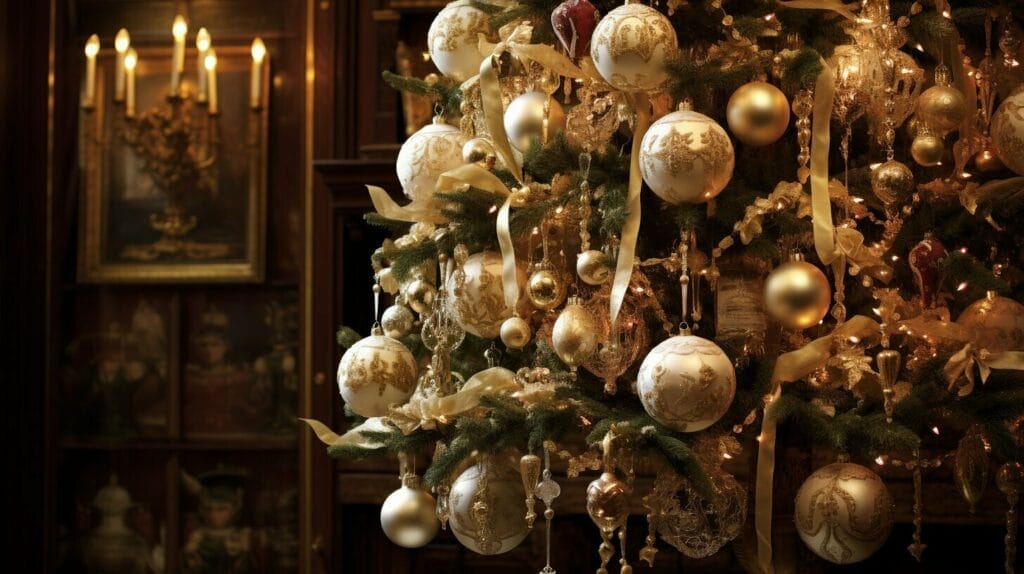
The tree has been an important symbol in winter festivals for centuries. In pagan cultures, it was believed that the evergreen tree had magical properties and represented eternal life.
The pine tree, in particular, held special significance as it was believed to ward off evil spirits. The tradition of decorating the tree with candles and ornaments was also an ancient practice, with each decoration holding its own symbolic meaning.
The use of the Christmas tree in Christian celebrations was adapted from these pagan rituals, with the evergreen tree representing immortality and the decorations symbolizing the joys of life.
Today, the tree remains a beloved symbol of the holiday season, with people all over the world continuing to decorate their homes with evergreen trees during the winter months.

While the practice has evolved over time, the symbolism and significance of the tree remain deeply rooted in ancient traditions. As you gather around your own Christmas tree this holiday season, take a moment to reflect on the rich history and traditions that have made it such a beloved part of winter festivals.
The Tree and Yule Log Relationship
One of the most fascinating aspects of the Christmas tree tradition is the relationship between the tree and the Yule log. In ancient times, the Yule log was believed to be a powerful symbol of the sun and was lit to ward off evil spirits during the long, dark nights of winter. The Yule log was typically a large piece of oak or ash wood, which would burn throughout the night and into the next day. The ashes from the Yule log were considered to be sacred and were often used in various rituals and ceremonies throughout the year.
The Yule log was often burned in a special fireplace or hearth, and the Christmas tree was placed nearby. The tree served as a symbol of life and nature, and was often adorned with various decorations and ornaments. In some cultures, the tree was decorated with fruits, nuts, and candles, which were said to represent the abundance of the earth and the promise of new life in the coming year.
As the tradition of the Christmas tree evolved over time, the relationship between the tree and the Yule log remained strong. Today, many families still burn a Yule log on Christmas Eve, and the tree is often placed nearby. The act of decorating the tree with lights and ornaments has also become a cherished holiday tradition, with families and friends coming together to celebrate the season and the spirit of togetherness.
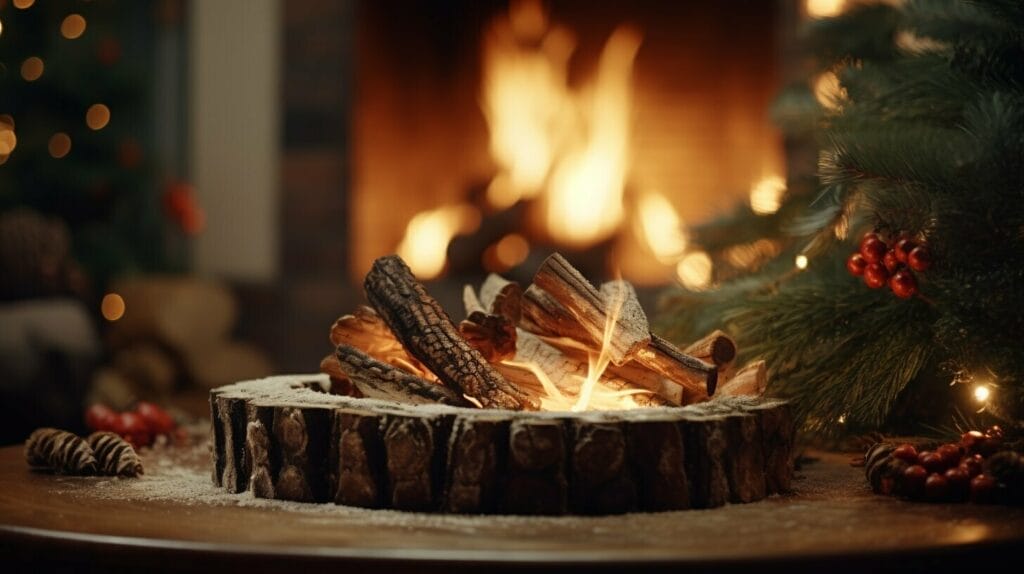
The ancient tradition of the Yule log and the Christmas tree reminds us of the deep roots of our holiday customs and the enduring power of nature and the cycles of life. As you gather around your own tree this holiday season, take a moment to reflect on the ancient traditions that have shaped our celebrations for centuries.
Prehistoric Tree Worship: Evidence from the Past
Long before the advent of Christianity, trees held significant cultural and religious importance in ancient European societies. Evidence of prehistoric tree worship rituals can be found in various archaeological sites, such as the Bronze Age rock carvings in Valcamonica, Italy, and the dolmens in Portugal.
These ancient cultures viewed trees as powerful entities with spiritual significance, believing that they were inhabited by pagan tree spirits. These spirits were believed to confer blessings and protection on those who showed reverence to the tree.
The lore surrounding pagan tree spirits has been passed down from generation to generation through oral traditions and mythologies. In Germanic mythology, for example, the god Odin hangs himself on the sacred Yggdrasil tree to gain wisdom and sacrifice to himself. In Celtic mythology, trees were gateways to the spirit world and represented strength, wisdom, and balance.
Early European tree customs centered around the veneration of specific tree species, such as the oak, ash, and holly. The oak tree, in particular, was considered sacred by the Celts, who believed it to be the king of all trees. They adorned these trees with offerings and celebrated them during the Winter Solstice.
As Christianity became the dominant religion in Europe, these pagan practices were gradually phased out. However, the reverence for the evergreen tree persisted, as it symbolized eternal life, which was later adapted as a symbol of the resurrection of Jesus Christ. The tradition of decorating these trees with ornaments and candles was incorporated into Christian Christmas celebrations, as a way to celebrate the birth of Jesus.
“Trees were gateways to the spirit world and represented strength, wisdom, and balance.”
The rich history of tree worship and the deep-rooted connections to pagan customs and rituals continue to influence modern celebrations of Christmas. Understanding the origins and symbolism of the Yuletide tree can deepen your appreciation of the holiday season and the enduring traditions that have been passed down through generations.
Modern Practices: Ancient Tree Lighting Rituals and the Evolution of Paganism in Christmas
You may have noticed that the lighting of the Christmas tree has become one of the most symbolic and anticipated events of the holiday season. This modern practice of tree lighting can be traced back to ancient tree lighting rituals that were part of pagan celebrations.
In many pagan cultures, lighting a tree with candles or other sources of light was a way to honor the winter solstice, celebrate the return of the sun, and mark the transition from darkness into light. Today, the act of lighting the Christmas tree represents similar values of hope and renewal after a season of darkness.
As paganism evolved into Christianity, the symbolism of the tree was adapted to represent the Christian holiday. The tree became a symbol of everlasting life, and the lights represented the light of Christ.
Christmas traditions have continued to evolve over time, and while the significance of the tree lighting may have changed, the practice itself has remained a beloved part of the holiday season. Many families continue to decorate their trees with lights and ornaments, imbuing them with personal meaning and creating cherished memories for generations to come.
In conclusion, modern practices associated with Christmas trees, such as the lighting of the tree, have ancient roots in pagan customs. While the meaning behind these practices may have evolved over time, they continue to shape our celebrations and remind us of the enduring significance of the evergreen tree in our lives.
FAQ
What are the origins of the Christmas tree?
The Christmas tree has deep-rooted connections to pagan customs and traditions. It is believed to have originated from ancient Yule tree traditions.
How were trees worshiped during the Winter Solstice?
The Winter Solstice was intertwined with the ancient Druids’ sacred tree worship. During this pagan festival, trees were venerated through rituals and practices.
What role did Germanic tribes play in the Yule celebration?
Germanic tribes celebrated the Yule festival and revered trees as part of their pre-Christian veneration. There are strong connections between Celtic tree worship rituals and early Germanic traditions.
What is the connection between the Roman festival of Saturnalia and the Christmas tree?
The Romans incorporated tree symbolism into their celebrations, and this later merged with pagan customs, influencing the Christmas tree tradition we know today.
How is Norse mythology connected to the adoption of the Christmas tree?
Norse mythology is associated with the sacred tree Yggdrasil. Ancient tree decorating practices influenced the adoption of the Christmas tree during the medieval period.
How did the Christmas tree transition from pagan to Christian traditions?
The Christmas tree evolved from its pagan roots to its Christian adaptation over time. Its symbolism and popularity increased during the Renaissance and Victorian eras.
What is the symbolism and significance of trees in winter festivals?
Trees hold symbolic importance in winter festivals, particularly the evergreen, with the pine tree having enduring pagan symbolism. Tree decoration is an ancient practice associated with these festivals.
How is the Yule log related to the Christmas tree?
The Yule log and the Christmas tree were both integral to ancient tree worship practices. They continue to intertwine in modern Christmas traditions.
What evidence exists of prehistoric tree worship?
There is evidence of prehistoric tree worship in ancient European cultures. Lore surrounding pagan tree spirits and early European tree customs provide insight into these practices.
Are there fertility links associated with the Yule tree?
Ancient cultures incorporated fertility symbolism into their tree worship practices during pagan celebrations, including those associated with the Yule tree.
What is the origin of ornaments and decorations used on Christmas trees?
Ornaments and decorations used to adorn Christmas trees have pagan origins. These ancient traditions were adapted into Christian practices while retaining their connection to the evergreen tree.
What modern practices are associated with Christmas trees?
Modern practices include ancient tree lighting rituals and the evolution of paganism in Christmas. These practices continue to shape modern celebrations.




